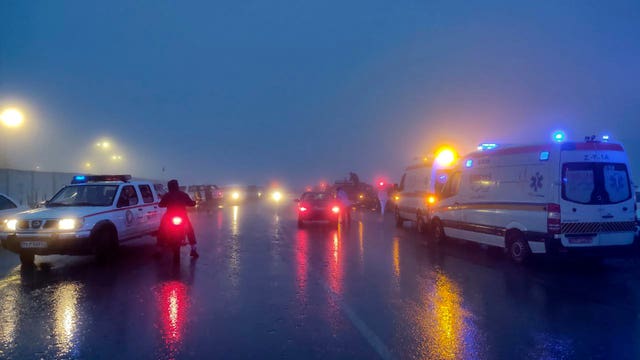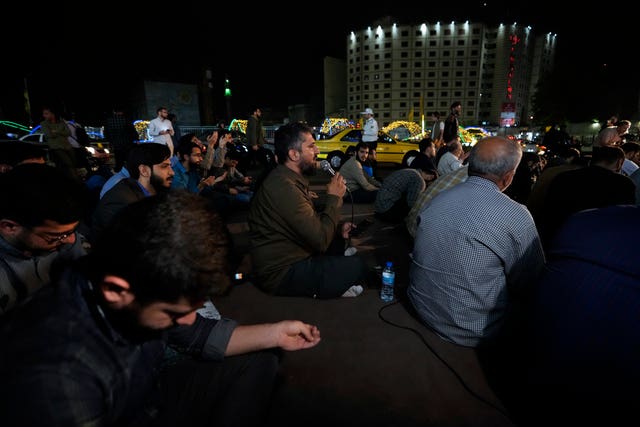Iranian President Ebrahim Raisi and the country’s foreign minister are among those found dead at the site of a helicopter crash after a search through a foggy, mountainous region of the country’s northwest, state media has reported.
Mr Raisi was 63.
The crash comes as the Middle East remains unsettled by the Israel-Hamas war during which Mr Raisi, under Supreme Leader Ayatollah Ali Khamenei, launched an unprecedented drone-and-missile attack on Israel last month.
Under Mr Raisi, Iran enriched uranium closer than ever to weapons-grade levels, further escalating tensions with the West as Tehran also supplied bomb-carrying drones to Russia for its war in Ukraine and armed militia groups across the region.
Meanwhile, Iran has faced years of mass protests against its Shiite theocracy over its ailing economy and women’s rights – making the moment that much more sensitive for Tehran and the future of the country.

State TV gave no immediate cause for the crash in Iran’s East Azerbaijan province.
Among the dead was Iranian foreign minister Hossein Amirabdollahian, 60.
Also with Mr Raisi was the governor of Iran’s East Azerbaijan province and other officials and bodyguards, the state-run IRNA news agency reported.
Early on Monday morning, Turkish authorities released what they described as drone footage showing what appeared to be a fire in the wilderness that they “suspected to be wreckage of helicopter”.
The co-ordinates listed in the footage put the fire 12 miles south of the Azerbaijan-Iranian border on the side of a steep mountain.
Footage released by the IRNA early on Monday showed what the agency described as the crash site, across a steep valley in a green mountain range.
Soldiers speaking in the local Azeri language said: “There it is, we found it.”
Condolences started pouring in after Iran confirmed there were no survivors from the crash. Neighbouring Pakistan announced a day of mourning and Indian Prime Minister Narendra Modi said in a post on X that his country “stands with Iran in this time of sorrow”.
Leaders of Egypt and Jordan also offered their condolences, as did Syrian President Bashar Assad.
Azerbaijan’s President Ilham Aliyev said he and his government were “deeply shocked” — Mr Raisi was returning on Sunday after traveling to Iran’s border with Azerbaijan to inaugurate a dam with Mr Aliyev when the crash happened.
Mr Khamenei himself urged the public to pray on Sunday night.
“We hope that God the Almighty returns the dear president and his colleagues in full health to the arms of the nation,” Mr Khamenei said, drawing an “amen” from the worshipers he was addressing.
However, he also stressed the business of Iran’s government would continue no matter what.
Under the Iranian constitution, Iran’s first vice president takes over with Mr Khamenei’s assent, and a new presidential election would be called within 50 days.
First vice president Mohammad Mokhber already had begun receiving calls from officials and foreign governments in Mr Raisi’s absence, state media reported.

Mr Raisi, 63, a hard-liner who formerly led the country’s judiciary, is viewed as a protege of Mr Khamenei and some analysts had suggested he could have replaced the 85-year-old leader.
Mr Raisi won Iran’s 2021 presidential election, a vote that saw the lowest turnout in the Islamic Republic’s history.
Under Mr Raisi, Iran now enriches uranium at nearly weapons-grade levels and hampers international inspections.
Iran has armed Russia in its war on Ukraine, as well as launched a massive drone-and-missile attack on Israel amid its war against Hamas in the Gaza Strip.
It also has continued arming proxy groups in the Middle East, like Yemen’s Houthi rebels and Lebanon’s Hezbollah.
Mass protests in the country have raged for years.
The most recent involved the 2022 death of Mahsa Amini, a woman who had been earlier detained over allegedly not wearing a hijab, or headscarf, to the liking of authorities.
The months-long security crackdown that followed the demonstrations killed more than 500 people and saw more than 22,000 detained.
In March, a United Nations investigative panel found that Iran was responsible for the “physical violence” that led to Ms Amini’s death.





Comments: Our rules
We want our comments to be a lively and valuable part of our community - a place where readers can debate and engage with the most important local issues. The ability to comment on our stories is a privilege, not a right, however, and that privilege may be withdrawn if it is abused or misused.
Please report any comments that break our rules.
Read the rules hereLast Updated:
Report this comment Cancel